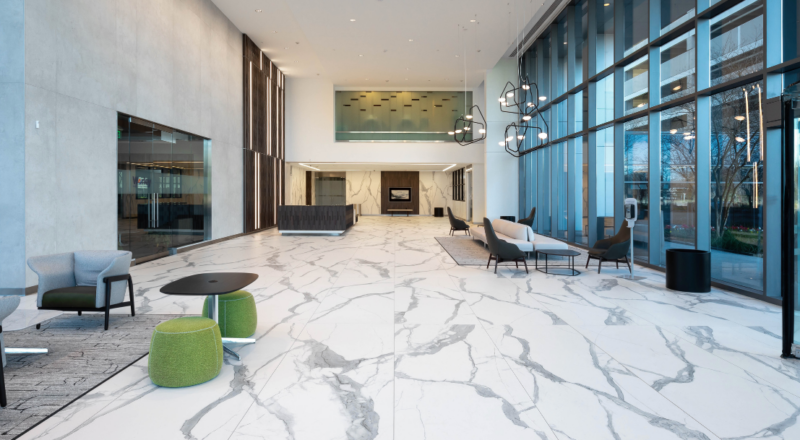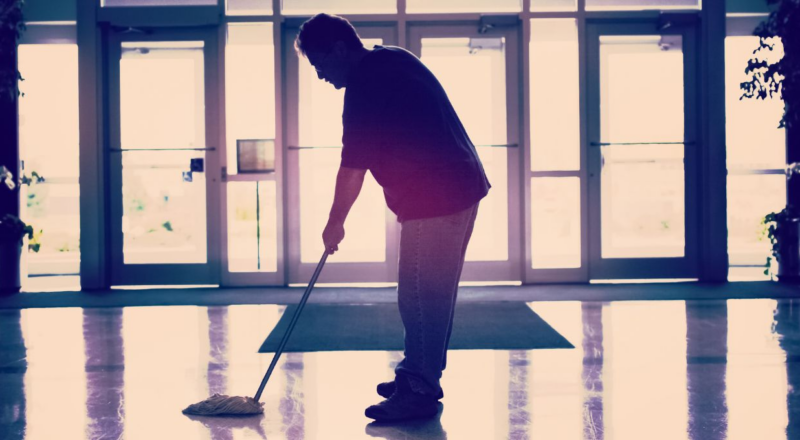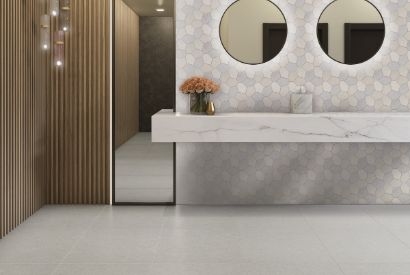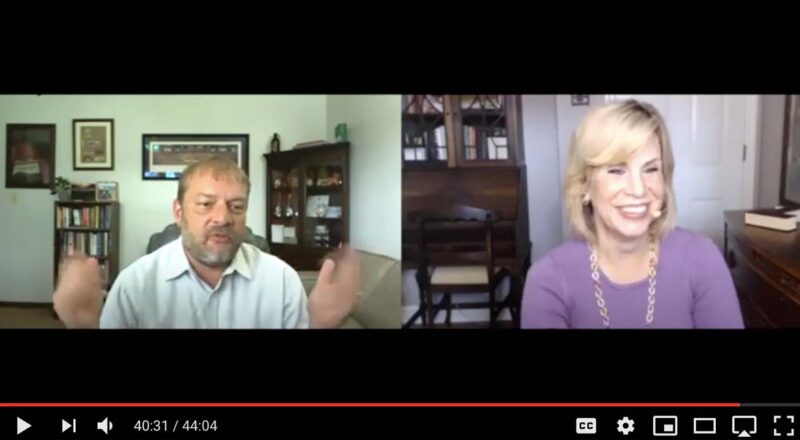Material ingredient transparency is also important in the tile industry. Designers and specifiers develop trust with manufacturers based on product information, training, and service. Developing more environmentally friendly spaces and LEED certified projects, designers and specifiers are expanding their knowledge base of all installed material ingredients and are searching for the third-party verification that builds trust with a manufacturer. At Crossville, we understand these challenges and strive to provide sustainability documents for all products and transparency in labeling.
Recently, the Tile Council of North America announced a collaborative initiative representing producers of ceramic tile, tile installation materials, and related products in providing industry-wide material ingredient transparency. According to the TCNA, “this collaboration, covering the ingredients from which ceramic tile and cementitious grouts and mortars are made, will produce a Material Ingredient Guide that includes Certified GreenScreen® Assessments of at least thirty of the raw materials most commonly used by the North American tile industry.” (See full press release.)
Noah Chitty, Crossville’s Director of Technical Services, further explained the significance of this industry collaboration in that the new Material Ingredient Guide will expand on existing programs that Crossville already participates in, such as the Health Product Declaration and Declare Label. Serving as a unified source to understand raw materials regularly used by the ceramic tile industry, the guide allows manufacturers to easily compile third-party verified material ingredient disclosures for our products.
The Material Ingredient Guide in the sustainability marketplace is really better for all of tile manufacturers because then we’re talking the same talk and walking the same walk, meaning when we get questions from designers or specifiers then we’re answering them in the same way, explained Chitty.
According to the TCNA, “Participating manufacturers will be clearly identified within the Guide and will have the ability to update their products’ proprietary documentation with validated and industry-supported data, making such products eligible for contribution at the highest level to green building programs such as LEED v4.1.”
Chitty further explained the significance related to LEED v4.1 in that the Material Ingredient Guide will assist in optimizing credits, especially as the green building rating systems evolve.
Tile Tech Talk with Noah Chitty (see 12:06 to 20:01 related to the Material Ingredient Guide)
Video Transcript
Irene (12:06)…
So my next topic: TCNA and members collaborate on material ingredient transparency in a game changing initiative.
Noah (12:46): Yeah. This one a little bit because it’s still, we’re still doing it, you know, as opposed to it’s done and I can kind of speak to where it was and what it’s gonna do. This one I think I’m still wrapping my head around completely but we’re participating in the effort. So, obviously I had to make the case for why we should do that.
Irene (13:08): So just explain the basics of it.
Noah (13:12): Of the material ingredient guide,
Irene (13:14): Right, for people who are not familiar at all.
Noah (13:18): Okay. Well I want to try and do it as simply as possible. So, we do things like EPDs and HPDs and declare labels and they really fall into two categories. So one is an EPD…what is your impact on the environment based on what you do as a manufacturer. The other two HPDs and declare labels are ingredient transparency. So tell us about the stuff you use to make the things you make and if there are any hazards associated with that. So kind of one level up from just using the information that’s out there is what’s called a green screen assessment, like a full toxicological review of a singular material and what its hazards are. So where we’ve been in the past is if you went, say we had 15 ingredients in our tile. If we wanted to go get a green screen assessment for each of those 15 ingredients, it might cost us $8,000 per ingredient.
Then another tile manufacturer who probably uses 13 or 14 of those same ingredients goes to get that done. And they have to pay $8,000 per ingredient for the exact same toxicological review because somebody else holds the database, basically. So even though their work got less ‘cause they already did it for you, it’s still holds. So we kind of said as an industry, what if we banded together because 13 out of 15 just for to put a number out there of our ingredients are always the same from manufacturer to manufacturer. What if we could do our own green-screen assessments and just the people who participated in the program? Right. So it’s not available to a whole industry. It’s kind of like the industry EPD. You can only capitalize on those credits if you are a named participant in that industry EPD. So it’ll be the same thing for this. Whoever agrees to participate in this work will have access to this database.
(15:35): So that’s the first idea. And then the question really is after that, now that you’ve had your ingredients green screen assessed, what do you do with that information? And that’s the part that I’m still kind of figuring out a little bit. I think there’s probably two things that are the usefulness of it. Maybe, maybe two or three, at least the way I understand it now and I think will it be able to utilize it more. I mean, but when we saw like a Tile Council press release and it had quotes from somebody at USGBC I think, and somebody else in the green building community, it was really good to see that recognition for the tile industry from people at that level. Because a lot of what we’ve done as a sustainability committee in spite of Tile Council and a lot of the efforts has really been to make sure that the tile industry is at the forefront of what’s being asked from a sustainability purpose. And if we look back 10 years ago, we weren’t there. We just thought tile was the most sustainable. Just figured that everybody should have recognized that too. But, it doesn’t work like that. If you don’t participate in the work of it, then you don’t really get it done. So I think one is just to stay in front as an industry. And then the second thing that’s a little more, in some ways I wish because we’re doing these things, we get to take advantage of it as Crossville. But the reality is that if you scale the program, and every manufacturer is using the same information and talking the same talk when we get these questions from the marketplace that kind of rise all ships.
(17:35): You know, that that scaling of the tile industry out to the sustainability marketplace really is better for all of us because then we’re talking the same talk and walking the same, when we get the questions, we’re answering them in the same way. Well, it’s good to be individual and doing maybe you know, more than others. The reality is we’ll get the most benefit if the tile industry itself is scaled from inside the sustainability community as ‘Oh well we know tile and we know what they’re bringing to the table.’ That’s going to help us all in the end.
Irene (18:12): Absolutely. Yes.
Noah (18:13): And then I guess the other two things are, I think what will allow us to do is things like our HPD and our declare labels. It will kind of allow them to, we can upgrade them. So right now the ingredient disclosures, but if you can get ingredient disclosures with a green screen assessment, third party verified, you know for this kind of thing. So it allows us to upgrade the information we already have.
Finally there’s all, there’s credits in LEED that are specifically called optimization, and the green at the material ingredient guide and this database will allow us to play in the optimization credits easier. That’s my simplistic idea of it so far and I think as it evolves, we’ll learn more about what we can do. Cause the reality is the green building rating systems are evolving.
So, I think our real effort as a sustainability committee for the industry is to stay ahead of the curve. What is coming next? How do we actually do something as an industry that allows us to say we’re doing something that people aren’t even barely even thinking about yet. You know, we’re going to be here, we’re going to be bat for you.
Irene (19:35): Yeah. And long term, I mean Crossville has such as solid sustainability stance, everything just supports that very well.
Noah (19:46): Yeah. Everything supports that. So, you know, it really should just make what we have more robust, and allow us to have even more sustainability story for the designers that are out there using the product.





